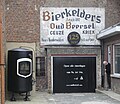Gueuze
Type of Belgian beer From Wikipedia, the free encyclopedia
Gueuze (French: [ɡøz] ⓘ; Dutch: geuze [ˈɣøːzə] ⓘ) is a type of lambic, a Belgian beer. It is made by blending young (1-year-old) and old (2- to 3-year-old) lambics, which is bottled for a second fermentation. Because the young lambics are not fully fermented, the blended beer contains fermentable sugars, which allow a second fermentation to occur.
| Gueuze | |
|---|---|
 Brouwerij Lindemans' Oude Gueuze Cuvée René | |
| Country of origin | Belgium (Zenne Valley, Pajottenland) |
| Yeast type | Spontaneous fermentation |
| Alcohol by volume | 5-9%[1] |
| Malt percentage | 60-70% |


Due to its lambic blend, gueuze has a different flavor than traditional ales and lagers. Because of their use of aged hops, lambics lack the characteristic hop aroma or flavor found in most other beers. Furthermore, the wild yeasts that are specific to lambic-style beers give gueuze a dry, cider-like, musty, sour, acetic acid, lactic acid taste. Many describe the taste as sour and "barnyard-like". Gueuze is typically highly carbonated, with carbonation levels ranging from 3.5 to 4.5 volumes of carbon dioxide.[2] Because of its carbonation, gueuze is sometimes called "Brussels Champagne".
In modern times, some brewers have added sweeteners such as aspartame to their gueuzes to sweeten them, trying to make the beer more appealing to a wider audience. The original, unsweetened version is often referred to as "Oude Gueuze" ("Old Gueuze") and became more popular in the early 2000s. Tim Webb, a British writer on Belgian and other beers, comments on the correct use of the term "'Oude gueuze' or 'oude geuze', now legally defined and referring to a drink made by blending two or more 100% lambic beer."[3]
Traditionally, gueuze is served in champagne bottles, which hold either 375 or 750 millilitres (12+3⁄4 or 25+1⁄4 US fl oz). Traditionally, gueuze, and the lambics from which it is made, has been produced in the area known as Pajottenland and in Brussels. However, some non-Pajottenland/Brussels lambic brewers have sprung up and one or two also produce gueuze – see table below. Gueuze (both 'Oude' and others) qualified for the European Union's (EU) designation 'TSG' (Traditional Speciality Guaranteed) in 1997/98, which prescribes a registered production method and product specifications for product called "gueuze" if produced or sold in the EU, but does not have the same legally protected status as a protected designation of origin or protected geographical indication.[4]
Etymology
The name was first seen as the Dutch word 'geuze-bier' in a French text in 1829.[5]
There is some debate on where the word gueuze originated. One theory is that it originated from geysa (geyser), Old Norse for gush, since, during times of vigorous fermentation, gueuze will spew out of the bunghole of its enclosing oak barrel.[citation needed]. Another one derives it from a street called 'Geuzenstraet' (Geuzen Street) in Brussels, an old street that used to host the former entrance of "La Bécasse" pub (the street is now erased; it was next to Rue de Tabora).[6]
Another theory derives it from the French word 'gueuse' (meaning pig iron or raw iron), as originally, gueuze was defined as raw (unblended), aged, but fine-tasting lambic.[7]
Méthode Traditionnelle
Summarize
Perspective
Some American craft breweries have begun blending young and old sour beers, to produce their own versions of the traditional gueuze.[8] In 2016 Jester King Brewery released a blended, spontaneously fermented beer which it labelled as "Méthode Gueuze."[9] However, the High Council for Artisanal Lambic Beers (HORAL) objected to the name,[10] and the two parties arranged a meeting in Belgium. Jester King Brewery had no status to represent other American brewers in this meeting, and American brewers were not bound by any agreements made by Jester King's representatives. HORAL and Jester King agreed that Jester King would use the designation "Méthode Traditionelle" as a style name in the future. Jester King invited other American brewers to use the Méthode Traditionelle designation for their gueuze-style beers,[11] and proposed a set of standards and a logo for Méthode Traditionelle beers.[12] The Méthode Traditionelle designation has not caught on among American brewers, being used only by Jester King and TRVE Brewing, and causing confusion not only with the Méthode Traditionelle used by French champagne makers and Languedoc-Roussillon wine makers, but also among American craft and home brewers making highly carbonated beer in the champagne style using the champagne-makers' traditional method.
Commercial production of Gueuze
Commercial production of gueuze commenced in the 19th century; modern breweries that produce gueuze include:
- 3 Fonteinen
- Boon
- Belle-Vue
- Cantillon
- De Cam
- Girardin
- Hanssens
- Lindemans
- Mort Subite
- Oud Beersel
- De Troch
- Tilquin
- Timmermans
Oude Gueuze breweries and beers
This section needs to be updated. The reason given is: These numbers are a decade old and could use an update. (October 2020) |
Information extracted from Webb.[13]
Pajottenland / Brussels
- Boon
- Mariage parfait Oude Gueuze (8%)
- Moriau Oude Gueuze (7%)
- Oude Gueuze (7%)
- Dekoninck Gueuze (6%)
- Cantillon
- Gueuze 100% lambic (5%)
- Lou Pepe Gueuze (5%)
- De Cam Oude Gueuze (6.5%)
- De Troch Cuvée Chapeau Oude Gueuze (5.5%)
- 3 Fonteinen
- Vintage Oude Gueuze (8%)
- Oude Gueuze (6%)
- Millennium Gueuze (7%)
- 50e Anniversary Gueuze (6%)
- Girardin
- 1882 Gueuze black label (5%)
- 1882 Gueuze white label (5%)
- Hanssens Artisanaal Oude Gueuze (6%)
- Lindemans Cuvée René Oude Gueuze (5.5%)
- Mort Subite Natural Oude Gueuze (7.2%)
- Oud Beersel Oude Gueuze (6%)
- Timmermans 'Limited Edition' Oude Gueuze (5.5%)
Non-Pajottenland / Brussels
- Gueuzerie Tilquin - Oude Gueuze Tilquin à l'Ancienne (6.4%)
- Van Honsebrouck - Gueuze Fond Tradition (5%)
Gallery of Oude Gueuze producers
- Geuzestekerij De Cam
Gooik
See also
References
Bibliography
External links
Wikiwand - on
Seamless Wikipedia browsing. On steroids.






